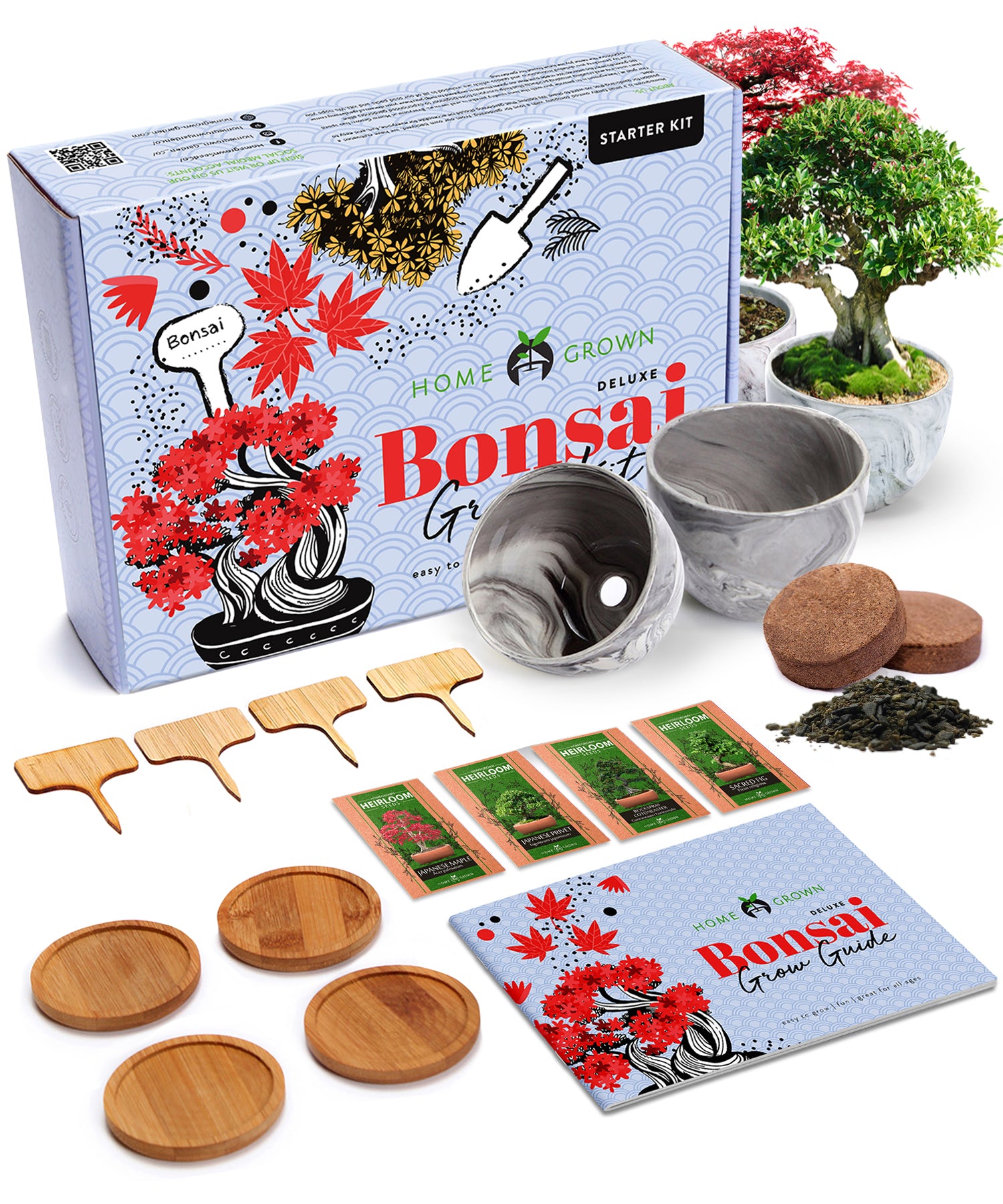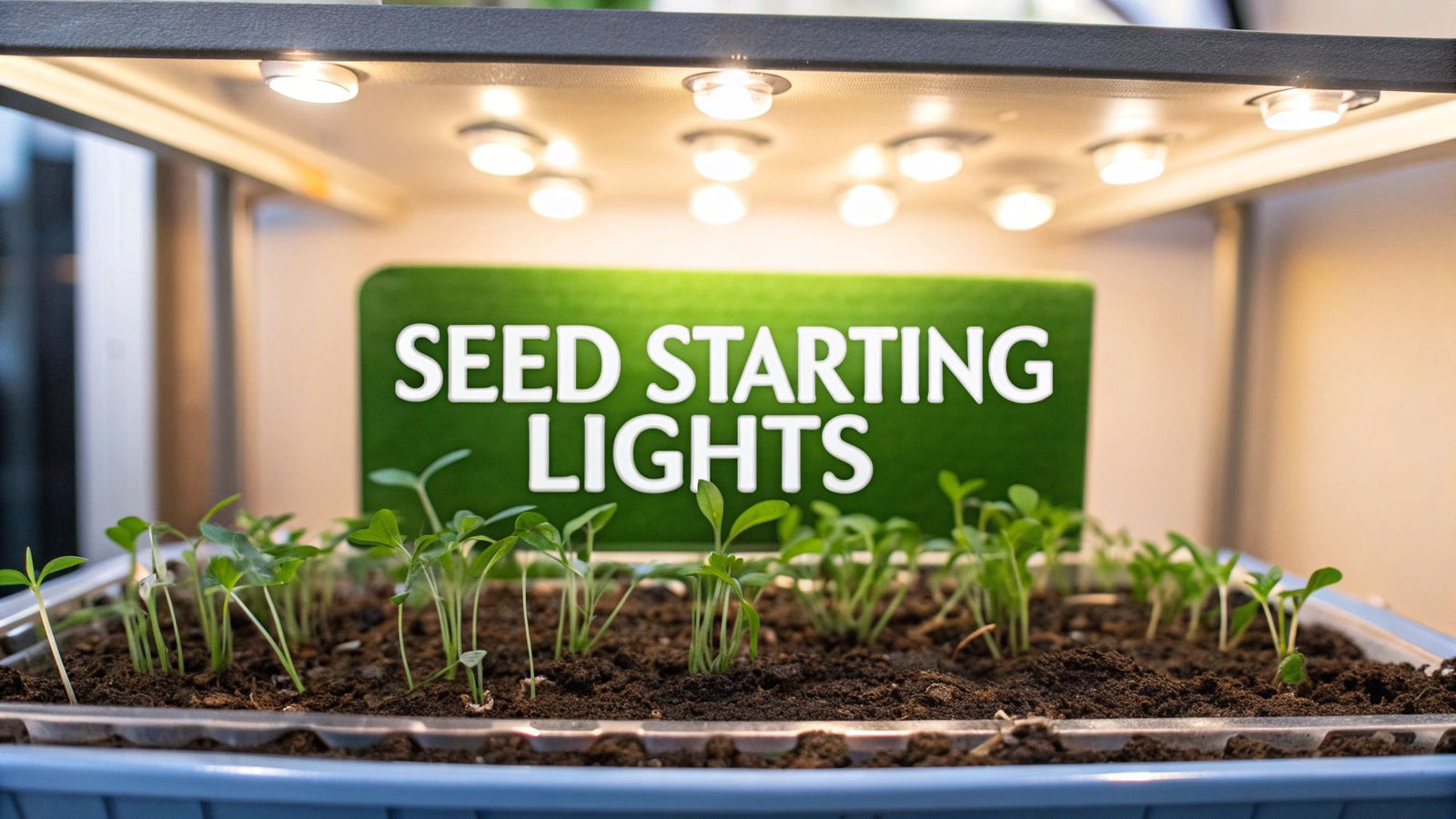
When it comes to starting seeds, your best bet is either a full-spectrum LED shop light or a T5 fluorescent fixture. Both options hit the sweet spot, delivering the right kind of light intensity and spectrum that seedlings crave for strong, stocky growth, and they do it without cooking your delicate little plants with too much heat.
5 Reasons Your Choice of Grow Light Is So Important
Picking the right grow light is probably the single most important decision you'll make when starting seeds inside. It's tempting to just stick your seed trays on a sunny windowsill, but that's rarely enough. Windowsills almost never provide the intense, direct, overhead light that seedlings need to thrive, especially during the short, often gloomy days of late winter and early spring.
This light shortage leads to a classic problem every gardener has faced: etiolation, or as we usually call it, "legginess." The seedlings desperately stretch toward the window, growing long, pale, and spindly stems. These leggy plants are incredibly fragile and often don't survive the transition when you move them out into the garden.
The Power of the Right Light
A good grow light setup solves the legginess problem completely. By providing consistent, powerful light directly over the tops of your plants, you encourage them to grow stout and bushy instead of tall and weak. The specific characteristics of that light—its spectrum, intensity, and how long it's on—are what really drive healthy plant development.
| Light Characteristic | How It Affects Seedlings |
|---|---|
| Light Spectrum | A "full-spectrum" or "daylight" (rated between 5000K-6500K) light imitates natural sun, fueling strong photosynthesis and leafy growth. |
| Light Intensity | Bright, direct light is the key to getting seedlings to develop thick, sturdy stems instead of stretching out. |
| Light Duration | A steady 14-16 hours of light per day gives seedlings the energy they need for fast, healthy growth. Using a simple outlet timer is the best way to manage this. |
Once you get these three factors dialed in, you've created the perfect environment for germination and early growth. A solid lighting setup is the foundation of a great garden, and you can learn more in our complete guide on seeding success for starting your garden indoors.
The goal is simple: provide an artificial light source so effective that the seedling doesn't "know" it's not real sunlight. This prevents stress and promotes the vigorous root and stem development necessary for a strong transplant.
In this guide, we’ll break down the top lighting options side-by-side, giving you the confidence to grow robust, garden-ready plants right from the start.
3 Main Types of Grow Lights to Understand
Before you can pick the right grow light for starting seeds, you need to know what you’re actually buying. When you start shopping around, you’ll find the market is dominated by three main technologies: LED, Fluorescent, and High-Intensity Discharge (HID). Each has its own place, and what works for a commercial cannabis operation is definitely not what you need for a tray of tomato seedlings.
Think of it like choosing an engine for a car. They all make the car go, but they achieve it with wildly different levels of power, efficiency, and cost. Let's walk through the fundamentals so you can feel confident in your choice.
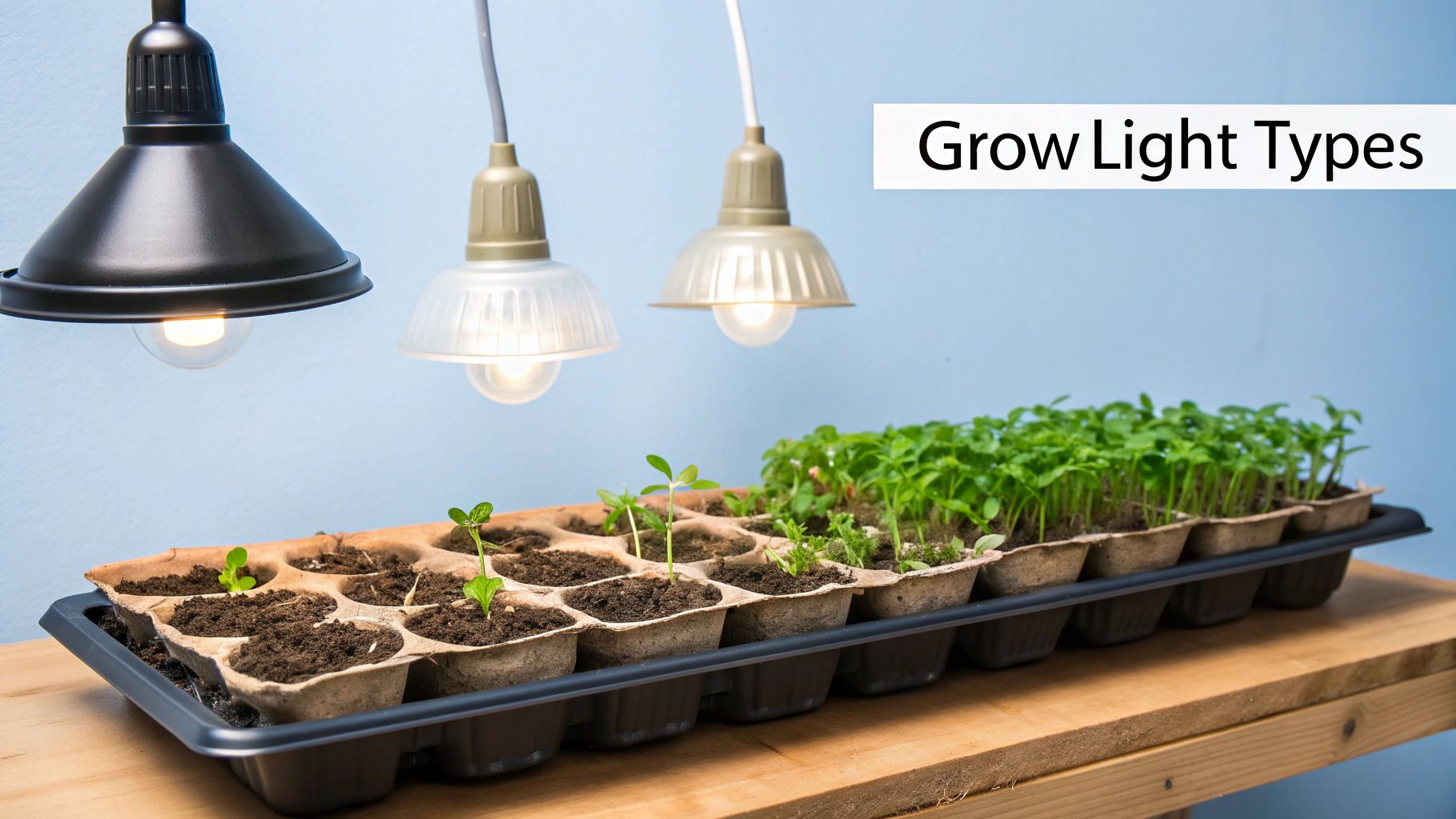
1. LED Grow Lights
Light Emitting Diodes (LEDs) have quickly become the modern standard, and for good reason. They work by passing electricity through a tiny semiconductor, which then emits light. The process is incredibly efficient and generates very little heat, a huge plus when you're dealing with delicate seedlings.
The real magic of LEDs is their customizability. Manufacturers can dial in the exact light spectrum, focusing on the specific red and blue wavelengths that plants crave for photosynthesis. This means no wasted energy producing green or yellow light that plants mostly reflect. The result is strong, stocky growth instead of leggy, weak seedlings.
2. Fluorescent Lights
For decades, fluorescent lights were the go-to for home gardeners and hobbyists. These lights work by sending an electrical current through a glass tube filled with argon and a tiny bit of mercury vapor. This creates invisible ultraviolet (UV) light, which then excites a phosphor coating on the inside of the tube, causing it to glow and produce visible light.
If you’re looking at fluorescents for seed starting, T5 high-output (HO) bulbs are what you want. The "T" just means the bulb is tubular, and the "5" refers to its diameter in eighths of an inch (so, 5/8"). They produce a bright, cool light that's perfect for seedlings, especially when you can hang the fixture just a few inches above the plant canopy. While not as efficient as LEDs, they are a proven, reliable, and often cheaper entry point.
A classic beginner mistake is grabbing old T12 shop lights from the garage. Modern T5 HO lights are nearly twice as efficient and kick out far more intense light. This makes a huge difference in keeping your seedlings compact and healthy.
3. High-Intensity Discharge (HID) Lights
HID lights are the absolute powerhouses of the grow light world. You’ll usually see two types: Metal Halide (MH), which gives off a cool, blue-white light great for leafy, vegetative growth, and High-Pressure Sodium (HPS), which produces a warm, orange-red light that triggers flowering and fruiting.
So, why not use them for seedlings? HIDs run incredibly hot and are major energy hogs. They're built for large-scale, commercial setups and are complete overkill for a simple seed-starting station at home. The intense heat they produce can easily fry fragile seedlings, making them an impractical—and potentially hazardous—choice for most gardeners.
It’s no surprise that the global grow lights market, valued at around USD 7.84 billion in 2024, is rapidly moving toward more efficient tech. Experts project massive growth, largely fueled by the clear advantages of LEDs for both home and commercial use, thanks to their long lifespan and lower running costs. You can read the full research about grow light market trends to see where the industry is heading.
A Comparison of the 7 Best Grow Lights for Starting Seeds
Stepping into the world of grow lights can feel like a deep dive, but choosing the right one really just comes down to your space, your budget, and how serious you are about your setup. I’ve broken down the seven most common options for starting seeds, moving past simple pros and cons to give you real-world advice on what works best in different situations. We'll focus on what really matters for seedlings: the quality of light, efficiency, heat, and overall value.
1. Full-Spectrum LED Panels (White Light)
For most home gardeners today, full-spectrum LED panels that cast a natural white or off-white light are the top of the line. They’re designed to mimic sunlight, giving your seedlings the complete range of light they need for strong, balanced growth. This makes them incredibly effective right out of the box.
Another big plus is that they're easy on the eyes, unlike the harsh purple "blurple" lights. This means you can actually see the true color of your seedlings and spot any issues early. They're also super energy-efficient and run cool, so you can hang them close to your trays without worrying about scorching delicate leaves.
Situational Recommendation: Perfect for the dedicated gardener who's ready to invest in a high-performance, long-lasting light that will deliver professional-quality seedlings.
2. LED Shop Lights (Full-Spectrum)
If you're looking for the best bang for your buck, full-spectrum LED shop lights are your answer. They deliver many of the same benefits as the more expensive panels—a great light spectrum, low heat, and amazing efficiency—but at a price that’s hard to beat. Think of them as the modern, supercharged successor to the old-school fluorescent shop lights many of us started with.
The key is to grab models with a color temperature between 5000K and 6500K. You'll usually see them labeled "Daylight" or "Cool White." This range is rich in the blue light that seedlings crave to grow stout and leafy, preventing that dreaded leggy stretch.
Key Insight: A common and highly effective setup is to hang two 4-foot LED shop light fixtures side-by-side. This gives you perfect, even coverage over a standard 1020 seed starting tray. It's simple, affordable, and it just works.
3. T5 High-Output (HO) Fluorescent Fixtures
Before LEDs took over, T5 HO fluorescents were the undisputed king of seed starting. And honestly, they still hold up as a fantastic, reliable choice. These fixtures pump out bright, intense light but generate very little heat, which is the magic combination that lets you hang them just inches above your seedlings for maximum light absorption.
The name says it all: "T5" refers to the tube's 5/8-inch diameter, and "HO" means high-output, making them way brighter than the older T8 or T12 bulbs. Their broad-spectrum output is proven to promote vigorous early growth.
Situational Recommendation: A great starting point for beginners or for gardeners who prefer a proven, no-fuss system without the higher initial cost of premium LEDs.
This infographic shows how modern LED panels can be engineered to deliver specific light spectrums—like the red and blue wavelengths that are critical for powering photosynthesis in young seedlings.
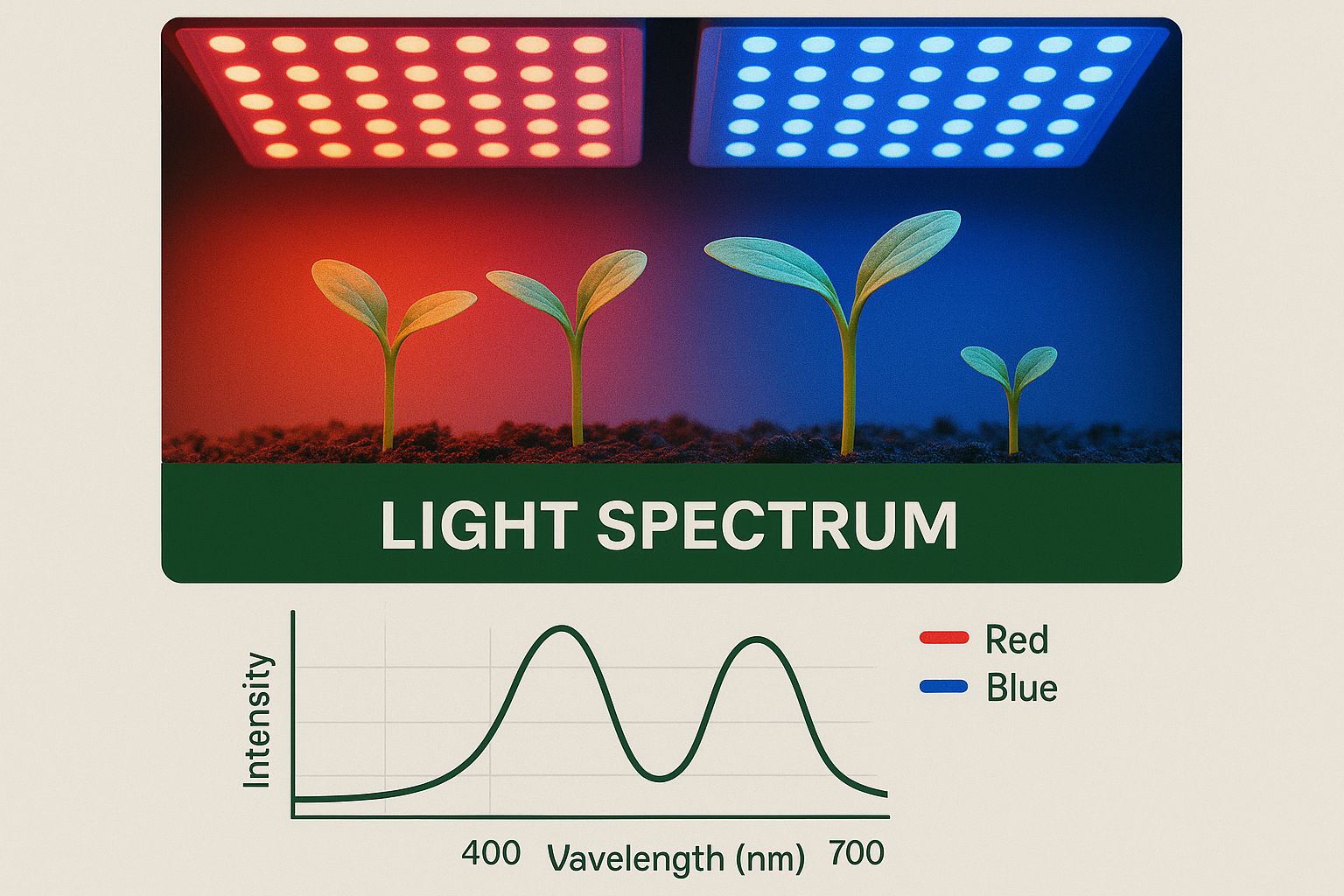
The ability to target the most useful wavelengths is a huge advantage, ensuring the energy you're paying for goes directly into growing healthy plants.
4. Quantum Board LED Lights
Quantum boards are the next level up in LED technology. They consist of a large board covered in hundreds of small, high-efficiency diodes. This design creates an incredibly uniform blanket of light, getting rid of the "hot spots" and dim edges you might get with other fixtures.
While they are often used for more light-hungry plants, lower-wattage quantum boards are phenomenal for starting seeds, producing exceptionally uniform and healthy seedlings. The upfront cost is higher, no doubt, but for serious growers, the superior performance and long lifespan make it a worthwhile investment.
This kind of innovation is why the LED grow light market is booming. Projections show it expanding from USD 3.51 billion in 2025 to an estimated USD 27.34 billion by 2035. That's a clear signal of how effective this technology is. For more on this trend, you can explore additional data on the rise of sustainable farming tech.
5. Bar-Style LED Grow Lights
If you’re planning a multi-level setup on a wire shelving unit, bar-style LEDs are a perfect fit. These are basically long, slim light strips designed to provide excellent coverage over rectangular trays. Many are linkable, which is a fantastic feature—you can connect several bars end-to-end and run them all from a single outlet.
This modular design makes them incredibly versatile. You can easily customize your lighting whether you're working with one shelf or a full five-tier rack. And like other modern LEDs, they run cool and sip electricity.
- Best Feature: Their slim profile maximizes the vertical space between shelves.
- Common Use Case: Ideal for the classic 4-foot wide wire racks so many people use for their DIY seed starting stations.
- Power Tip: Look for kits that come with hanging clips and daisy-chain cords to make installation a breeze.
Situational Recommendation: The hands-down best choice for anyone building a multi-tiered seed starting rack who needs a flexible, space-saving solution.
6. Red/Blue (Blurple) LED Panels
These are the lights that produce that iconic, almost futuristic pinkish-purple glow. They were some of the first affordable LEDs on the market and focus only on the red and blue light wavelengths that drive photosynthesis. While they do work, they come with a few notable drawbacks for home growers.
The biggest issue is that the unnatural color makes it really hard to properly inspect your plants. It’s tough to spot pests or diagnose a nutrient deficiency when every green leaf looks purplish-brown. Plus, a lot of modern research suggests seedlings actually benefit from the wider range of colors found in full-spectrum white light.
Situational Recommendation: A decent budget pick if you find one on a deep discount, but for a similar price, you can almost always find a full-spectrum white LED that offers a better growing experience.
7. Compact Fluorescent Lights (CFLs)
For someone with very little space—maybe just a few pots on a windowsill or a small desk—a couple of high-wattage CFL bulbs can get the job done. You’d need to use "daylight" bulbs (6500K) with a high lumen output (at least 2,000 lumens each) and position them extremely close to the seedlings.
Honestly, this is a last-resort option. The light coverage is spotty at best, and you'll need a clunky setup with multiple clamp-light fixtures to illuminate even a small area. It works in a pinch, but it's quickly outmatched by any other light on this list if you're starting more than one or two plants.
Seed Starting Grow Light Comparison
To pull it all together, here’s a quick side-by-side look at how these seven options compare across the key factors for starting seeds indoors.
| Grow Light Type | Best For | Light Spectrum | Energy Efficiency | Heat Output | Avg. Cost |
|---|---|---|---|---|---|
| Full-Spectrum LED Panel | Overall performance and plant health | Excellent (Mimics sun) | Very High | Very Low | Moderate-High |
| LED Shop Lights | Budget-conscious gardeners | Good (Choose 6500K) | Very High | Very Low | Low |
| T5 HO Fluorescent | Proven reliability and beginners | Good (Broad spectrum) | Moderate | Low | Low-Moderate |
| Quantum Board LED | Serious growers seeking uniformity | Excellent (Even coverage) | Highest | Low | High |
| Bar-Style LED | Multi-level shelving setups | Excellent (Customizable) | Very High | Very Low | Moderate |
| Red/Blue LED Panel | Basic, no-frills functionality | Targeted (Red/Blue only) | High | Low | Low-Moderate |
| CFL Bulbs | Very small, limited-space setups | Fair (Requires specific bulbs) | Low | Moderate | Very Low |
In the end, the best grow lights for seed starting are the ones that align with your space, your budget, and how big you plan to go. For most people, a set of full-spectrum LED shop lights or a classic T5 HO fixture strikes the perfect balance of cost and performance, giving your seedlings the powerful start they need to thrive.
How to Set Up Your Grow Light System in 2 Easy Steps
Picking out a great grow light is only half the battle. How you set it up is what truly makes the difference between success and failure, turning that new light into the perfect environment for raising strong, garden-ready seedlings.
Getting your setup dialed in is all about avoiding the two most common pitfalls: lights hung too close will scorch your delicate plants, while lights hung too far away will cause them to stretch into weak, "leggy" versions of themselves. Each type of light has a different sweet spot, so let's break it down.
Step 1: Find the Perfect Hanging Height
The distance from your light to the tops of your seedlings is easily the most important adjustment you'll make. Different lights put out different levels of intensity and heat, so a single rule just won't work.
Here are my go-to starting points for hanging different types of grow lights:
- T5 HO Fluorescent Lights: These run exceptionally cool, which is their main draw. You can get them right down to 2 to 4 inches above your seedlings for maximum light without any fear of burning them.
- LED Shop Lights and Panels: Modern LEDs are fantastic because they're efficient and also give off very little heat. A starting distance of 4 to 6 inches above the plant canopy is a reliable rule of thumb.
- Quantum Board LEDs: These are the powerhouses, so you need to give them more breathing room. I recommend starting them 12 to 18 inches away and keeping a close eye on your plants for the first few days.
Your plants will tell you if the height is wrong long before a ruler will. If you see seedlings stretching toward the light and looking pale, the light is too high. If you notice white or yellow spots appearing on the leaves, they're getting scorched—the light is too low.
As your seedlings shoot up, you have to raise the lights to maintain that ideal distance. This is precisely why a good setup with adjustable chains and S-hooks is a game-changer. I check my seedlings every couple of days and tweak the light height as needed to keep them in that perfect growth zone. For more on building out your entire system, check out our full guide to creating an indoor seed starting setup.
Step 2: Set the Perfect Light Schedule
With your lights hanging just right, the next step is to nail down a consistent daily light schedule, or photoperiod. Seedlings need a long, predictable "day" to power their growth, but they also absolutely require a period of darkness to rest and process all that energy.
For pretty much any vegetable or flower you plan to start, the sweet spot is 14 to 16 hours of light per day. This long, steady cycle gives them all the energy they need for robust root and leaf development. Don't even think about trying to manage this manually—you'll inevitably forget to turn them on or off, stressing your plants.
An Automatic Timer Is Non-Negotiable
A simple outlet timer is the best small investment you can make for your seed-starting setup. You set it once and it handles the rest, guaranteeing your seedlings get the exact same amount of light, day in and day out. This consistency eliminates guesswork and promotes the kind of uniform, vigorous growth we're all after.
3 Things to Look for When Buying a Grow Light
Stepping into the world of grow lights can feel a bit like learning a new language. Product pages are littered with technical jargon, but for starting seeds, you only need to master a few key terms. Once you know what to look for, you can confidently pick the right light without overspending on features meant for more demanding plants.
Let's break down the specs so you can shop like a pro.
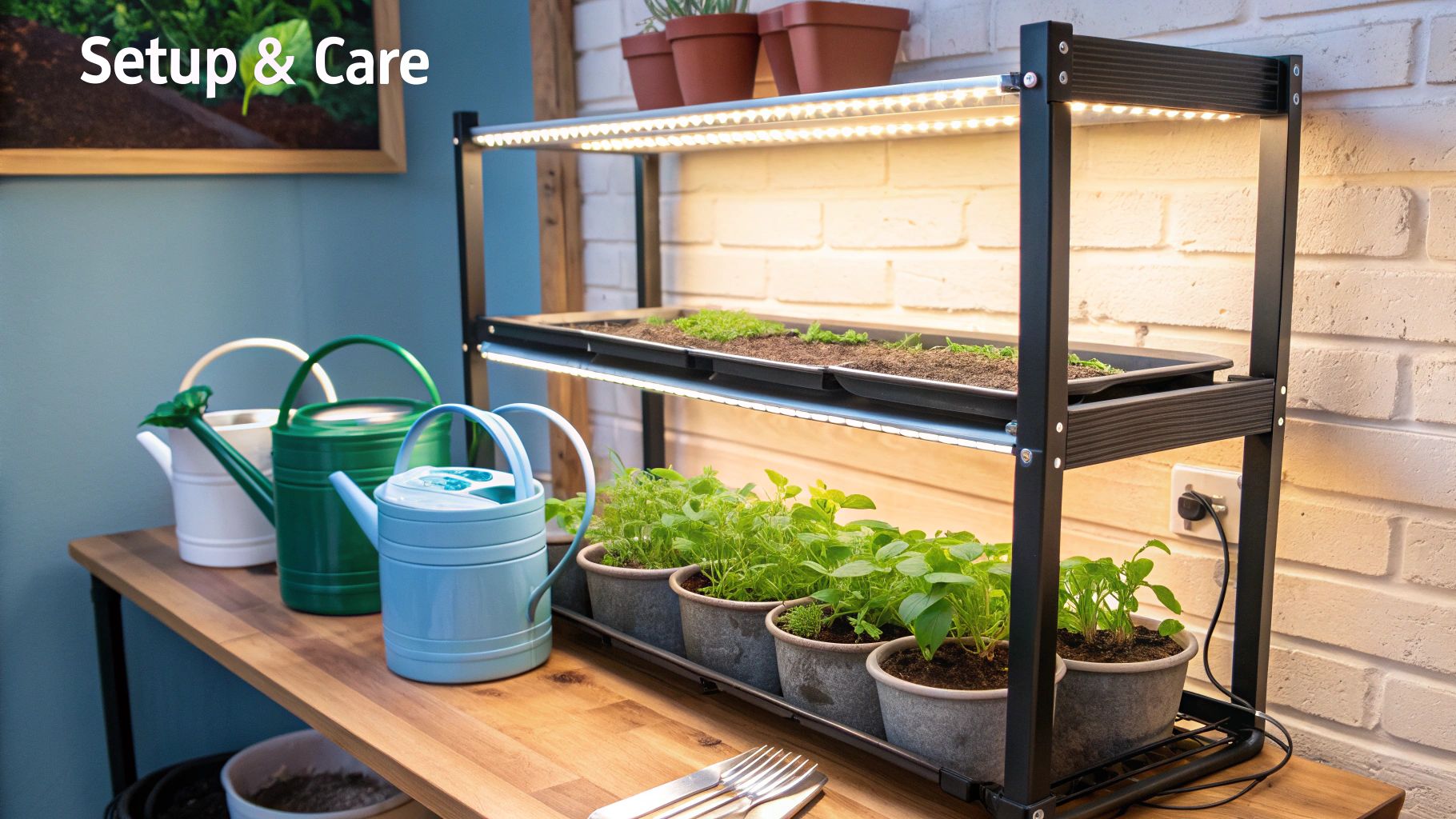
It's no surprise that the options feel endless. The global market for grow lights was valued at USD 2.0 billion in 2024 and is expected to hit USD 6.4 billion by 2029, a boom driven by the push for year-round food production. You can discover more insights about these market dynamics if you're curious about the industry's growth. For us, this just means more choices than ever before.
1. Decoding Light Spectrum and Color Temperature
Of all the specifications, the most important one for seedlings is the light's color temperature, measured in Kelvin (K). This number tells you if the light appears "warm" (leaning toward red) or "cool" (leaning toward blue). Seedlings need cool, blue-spectrum light to develop strong, stocky stems and lush leaves, which keeps them from getting weak and "leggy."
For the best results, aim for a Kelvin rating between 5000K and 6500K. These lights are typically marketed as "Daylight" or "Cool White" because they do a great job of mimicking the crisp, bright sunlight of a spring day.
2. Understanding Light Intensity Metrics
While Kelvin tells you about the quality of the light, a few other metrics describe its quantity. You'll almost certainly run into acronyms like PAR and PPFD on product pages.
- PAR (Photosynthetically Active Radiation): Think of this as the definition of "plant-usable light." It isn't a measurement itself but simply describes the range of light wavelengths that fuel photosynthesis.
- PPFD (Photosynthetic Photon Flux Density): This is the number that really matters. PPFD measures how much of that useful PAR light actually reaches your plants. For starting seeds, a PPFD between 100-300 µmol/m²/s is the sweet spot.
Don't get upsold on lights with extreme PPFD values of 600 or more. Those are built for heavy-duty flowering and fruiting. Stick to the 100-300 range, and you'll get healthy seedlings without paying for power you don't need.
3. Wattage, Coverage, and Safety
Finally, let's touch on the practical side of things. A light's wattage tells you how much electricity it uses, not how bright it is. Thanks to technology, an efficient 30-watt LED can easily outshine an old 60-watt fluorescent tube.
What's more important is the manufacturer's recommended coverage area. A standard 4-foot light fixture, for example, is usually perfect for two 10x20-inch seed trays sitting side-by-side. Make sure your light is sized to bathe all your seedlings in even light.
And please, don't forget safety. Always look for lights that have UL or ETL certifications. These independent seals mean the product has been rigorously tested and meets accepted safety standards, giving you peace of mind that you're not creating an electrical hazard.
Your Top 4 Questions About Seed Starting Lights Answered
Even after you've picked the perfect grow light, a few questions are bound to come up. It's totally normal. Here are the most common things gardeners ask, with straight-to-the-point answers to help you get growing.
1. Can I Just Use a Regular Lamp from My House?
I get this question all the time, and the short answer is no. A standard incandescent or halogen bulb from a desk lamp just won't cut it for seedlings.
Those bulbs throw off a ton of heat and produce light in the wrong part of the spectrum. You'll either end up scorching your delicate new plants or they'll grow into weak, "leggy" seedlings that can't support themselves.
Seedlings are hungry for cool, blue-spectrum light that feels like a bright spring morning. That’s why grow lights with a color temperature between 5000K and 6500K work so well—they deliver the exact energy plants need for photosynthesis without the damaging heat.
2. How Can I Tell if My Seedlings Are Getting Too Much or Too Little Light?
Your seedlings will tell you exactly what they need; you just have to learn their language. Reading these visual cues is one of the most useful skills you can develop for starting seeds indoors.
- Too Little Light: The classic sign is "legginess." The seedlings will literally stretch themselves thin, reaching for the light source. This leaves you with long, pale, and flimsy stems that often fail once transplanted.
- Too Much Light: If your light is too intense or too close, you might see bleached white or yellow spots on the leaves—that's a classic case of light burn. The leaf edges can also look brown and feel crispy to the touch.
The sweet spot is when your seedlings grow short, stout, and a healthy, vibrant green. For T5s or LEDs, this usually means keeping the lights just a few inches above the tops of the plants and raising them as they grow.
3. What's the Real Difference Between Blue and Red Light?
While a full-spectrum light is always the best bet, it helps to know what each color does for the plant. Think of it like a plant's diet, where different colors fuel different types of growth.
- Blue Light (Cool Light): This is the engine for vegetative growth. It promotes strong stems and thick, green leaves. For starting seeds, a light source that's heavy on the blue spectrum is what gives you those stocky, compact seedlings we're all after.
- Red Light (Warm Light): This part of the spectrum comes into play later on. Red light is what tells a plant to start flowering, budding, and producing fruit. Seedlings use a little bit, but it's not their main course during the early growth stage.
A full-spectrum bulb gives your plants a balanced meal. But by choosing one with a high Kelvin rating (like 6500K), you're ensuring it has that strong dose of blue light they need to get a great start. Of course, getting the timing right is just as important. If you need a refresher, you can learn more about when to start seeds indoors to build the perfect schedule.
4. Do My Grow Lights Need to Be on 24/7?
Definitely not. In fact, that would do more harm than good. Plants need a rest period, just like we do. They use the dark hours to process the energy they stored up during the day in a process called respiration.
Leaving your lights on 24 hours a day will stress your seedlings out, which can lead to stunted growth and even prevent them from absorbing nutrients properly. The gold standard for almost all seedlings is a consistent cycle of 14 to 16 hours of light, followed by 8 to 10 hours of complete darkness. An inexpensive wall timer is the easiest way to lock in this schedule and forget about it.
Ready to grow stronger, healthier seedlings this year? At Homegrown Garden, we have everything you need, from heirloom seeds to the perfect starter kits. https://www.homegrown-garden.com

